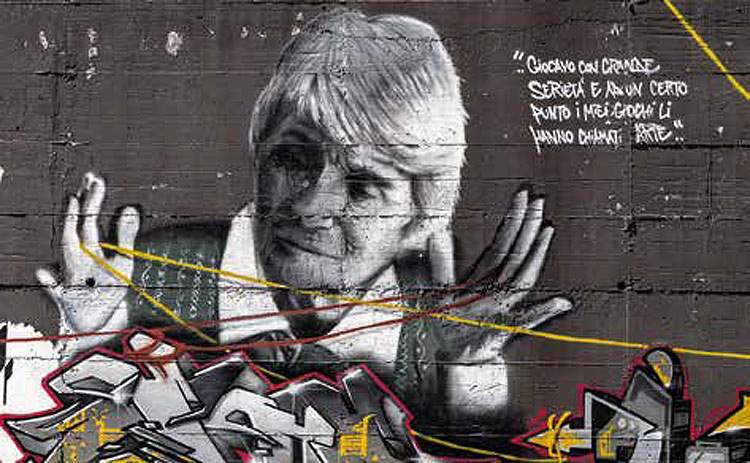The first guide to Sardinia's murals and street art is released
Entitled Walls of Sardinia. Places and Works of Street Art the guide to the famous murals of Sardinia and, in general, to the places of street art on the island coming out next August 20, published by Dario Flaccovio Editore. The volume, designed and produced by Asteras Associazione Culturale (which is based in Cagliari, is composed of art historians and photographers and operates in Sardinia in the field of cultural heritage and visual arts), is edited by Barbara Catte, Gianfranca Loi and Ivana Salis (who wrote the texts and apparatus) with editorial coordination by Elisabetta Borghi, and contains photographs by Massimiliano Frau. Over four hundred pages with the works of Sardinian urban art all divided into macro-areas and indexed on the basis of cities.
Sardinia has a long tradition of urban art: on the island, reads Elisabetta Borghi’s introduction, "there is a muralism dating back to the 1970s that can now be called historical, while since the 2000s Street art has appeared, acting in the context of urban redevelopment. Even before the cases of San Sperate (Museum Country) and Orgosolo, single and important episodes happened in Sardinia. In 1950, on an interior wall in the guest quarters of the Monteponi mine in Iglesias, Aligi Sassu painted the large fresco La miniera (The Mine), which was restored in 1997 and bound in 2014 by ministerial decree: a tribute to the work of the miners, a mural that has a realistic narrative structure and a strong civic character. ALIGI SASSU pictor.sardus.fecit 1950, leaves written the painter on the wall in the upper right, as if to emphasize his adherence to the context in a declared social solidarity." And then again Costantino Nivola’s graffito executed in 1958 on the façade of the church of Madonna d’Itria in Orani, Nivola’s wool walls of 1966, the ribbons with which, in 1981, Maria Lai “tied” the mountain between Orani and Ulassai, passing through the first mural in San Sperate, painted in 1968 by Pinuccio Sciola. Sardinia is thus a land of great street art.
An art that is not only found in the main cities, such as Cagliari, Sassari, Oristano or Nuoro, but also in the urban centers of the territory, recovered to a conscious use of traditions, on the walls of homes and public buildings. Street art is thus a major artistic phenomenon for Sardinia, aligning the Sardinian island with the international context. The guide aims to offer the traveler a useful tool for researching and understanding the most emblematic elements: from the renowned murals of Orgosolo and San Sperate to the new street art of San Gavino Monreale. From the 1960s to the 2000s. Great performers and young utopias: a fascinating circuit, instructive and full of surprises. The book therefore aims to stand as a practical guide to take on the road, as well as a small iconographic atlas of the feelings, visions and hopes of the Sardinian people.
Putting together all Sardinian street art, reads a note from Dario Flaccovio Editore, "is a difficult operation, as well as a research to give memory to ephemeral works that if catalogued and analyzed from a sociological and semiotic point of view represent a socio-cultural map of rituals, presences on the territory and different ways of experiencing it: this, tries to do Muri di Sardegna, the first guide to the island’s wall works edited by the cultural association Asteras."
“We undertook the guide project,” the association’s members recount, “with the aim of highlighting the extent of this peculiarity of Sardinia’s urban and suburban landscape: it is an immense, constantly changing visual heritage that represents a true unicum.”
The “Walls of Sardinia” project was also realized thanks to the support of the municipalities of San Nicolò d’Arcidano, Capoterra, San Sperate, Escolca and Silius, and under the patronage of the municipalities of Guspini, Nuoro and Cagliari. The book (424 pages, 15 x 21 format) is on sale for 24 euros. For info, it is possible to consult the Dario Flaccovio Editore website.
Pictured: SAF Crew, ElevenSix Squad, Neo-Ink, A Maria Lai, detail (2016; Cagliari, CUS, via Is Mirrionis)
 |
| The first guide to Sardinia's murals and street art is released |
Warning: the translation into English of the original Italian article was created using automatic tools. We undertake to review all articles, but we do not guarantee the total absence of inaccuracies in the translation due to the program. You can find the original by clicking on the ITA button. If you find any mistake,please contact us.



























